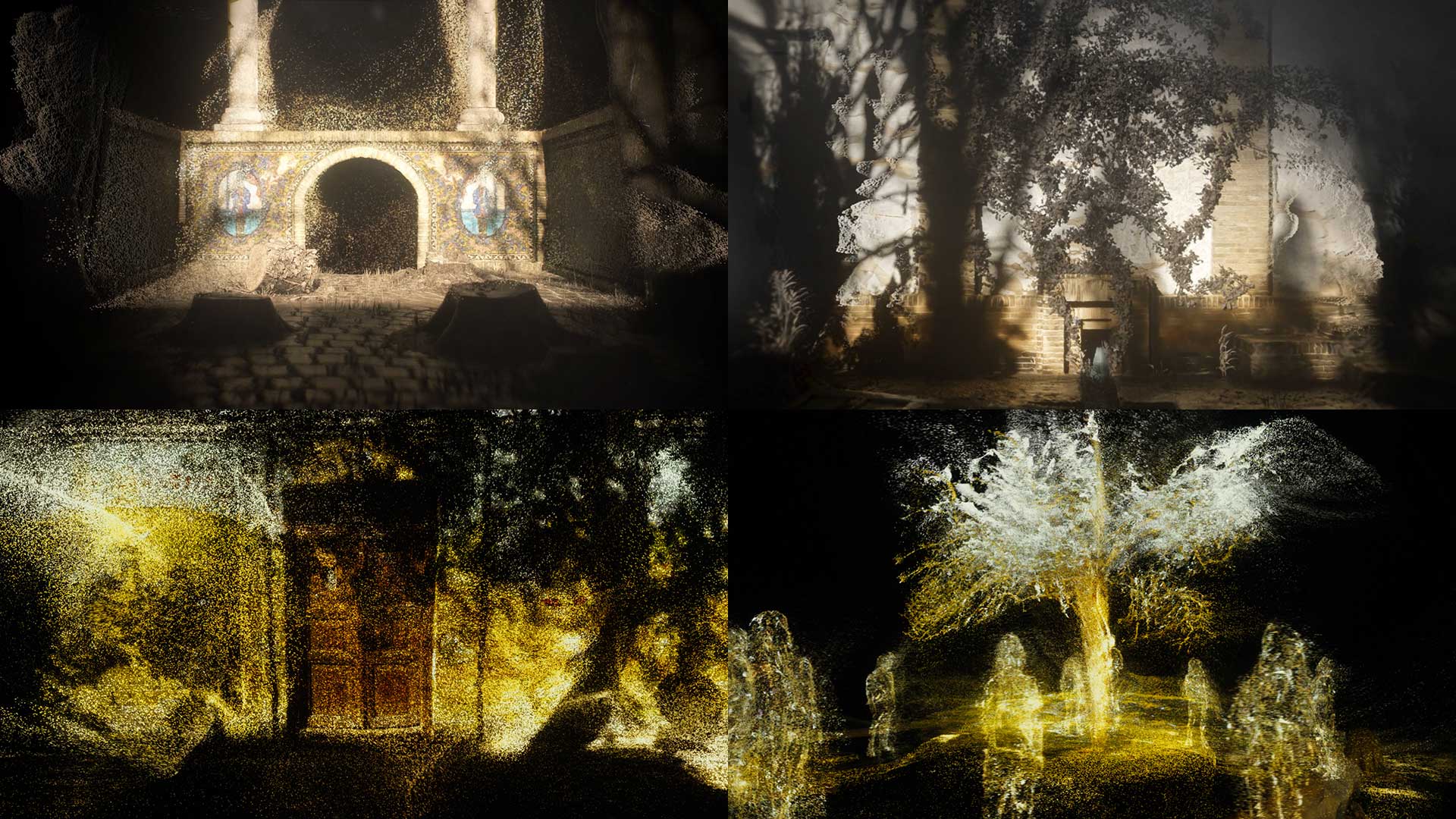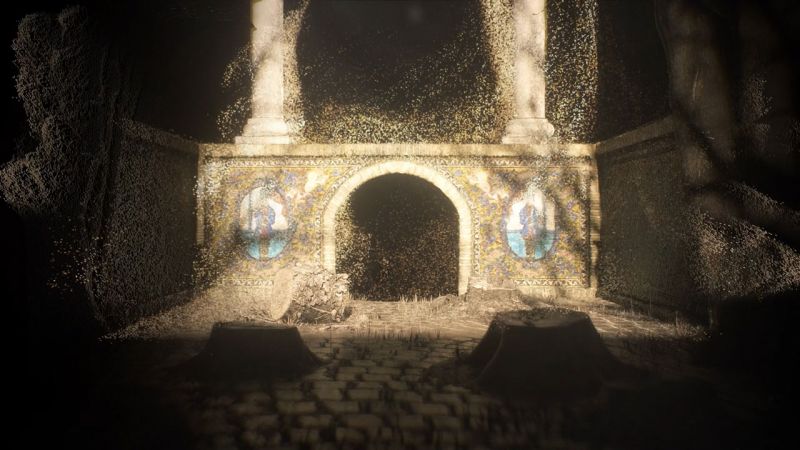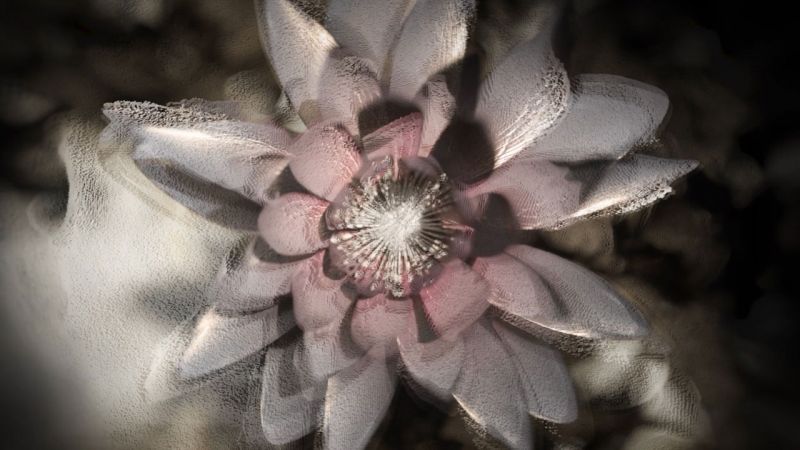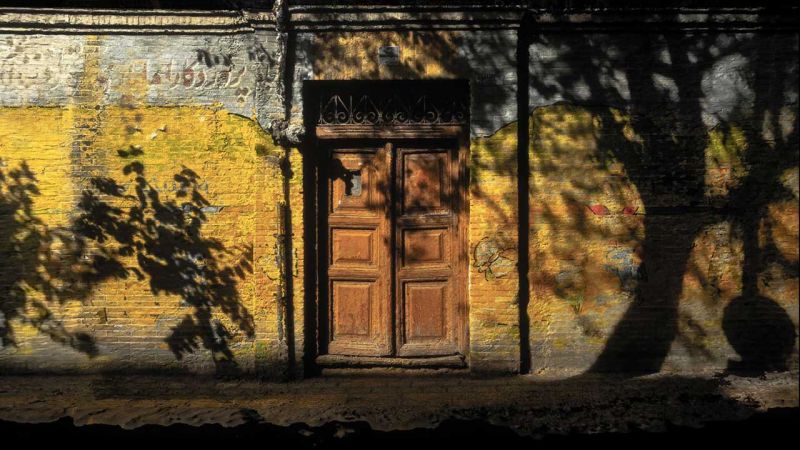In the collection “The Blind Owl” he aims to reconstruct parts of the beauty of past events and the memories that remain in a space. He has created his work by photographing many pictures of Sadegh Hedayat’s house and recreating these images. This collection is a reminder of his childhood memories that are associated with some concepts and images in his mind; mental images that are intertwined and unclear, and although they seem like they lack narration, the viewer can conjure and dream up the narration of this place they have never seen.
The photographs have only captured the outer parts of the house, such as the outer walls and the courtyard; and with not entering inside, the artist aims to come close to the heavy shadow of censorship that was weighing on Hedayat’s life and to portray his immense isolation and solitude.
Shahravan has used digital technology to create abstract images of the real world, images that fracture and are tangled in each other, finally weaving together reality and the artist’s mental plain.
بهزاد شهروان (م. 1370، تهران، ایران) دانش آموخته کارشناسی ارتباطات تصویری در دانشگاه سوره است. او آثارش را بدون محدود شدن به فرم سنتی هنری با رسانهی ویدئو، طراحیهای دیداری و شنیداری خلق میکند و به واسطهی صدا و تصویر، زبان هنری خود را شکل میبخشد.شهروان با نگاهی به خاطرات، اجتماع و فرهنگ به خلق روایتهایی می¬پردازد، داستانپردازیای که جستجوگرانه و در راستای انتقال مفاهیم مورد نظر و احساساتش است.
بهزاد شهروان در مجموعهی «بوف کور» به بازسازی بخشی از زیبایی رویدادها و حافظهای که در فضا باقی مانده است میپردازد. او با ثبت عکسهای متعدد از خانهی صادق هدایت و بازساختن این تصاویر اثرش را خلق کرده است. این مجموعه برای هنرمند یادآور خاطراتی از کودکی او است که در ذهنش تداعیکننده مفاهیم و تصاویری هستند؛ تصاویری ذهنی که ادغام شده و نامشخصاند و با اینکه فاقد روایت به نظر میرسند اما ببینده میتواند روایتی را از جایی که هرگز ندیده در ذهنش رؤیاپردازی کند. این تصاویر فقط از قسمتهای بیرونی خانه، همانند دیوارها و حیاط است و هنرمند با وارد نشدن به فضای اندرونی به بازسازی نگاه سانسوری که در زندگی هدایت سایه انداخته بود نزدیک میشود و انزوای نویسنده را به تصویر بکشد. شهروان با استفاده از فناوری دیجیتال تصاویری از دنیایی واقعی ساخته که انتزاعی هستند، دچار گسست میشوند و مرز آنها درهمتنیده میگردد و در نهایت فضای عینی را به جهان ذهنی خود پیوند داده است.

Sadegh Hedayat House is located at No.3, Shahid Taghavi St., Saadi St., Tehran. Hedayat House was built by order of his father Etezadolmolk, who was one of the nobles of the Qajar period, and its shape and structure go back to the style of the late Qajar period. Initially, it was intended to turn the house into a museum. But this did not happen, and it was given to Tehran University of Medical Sciences. Then, it was used as a staff kindergarten - "Sadeghieh Kindergarten"-
The blistering and cracked walls of the courtyard, the termite-infested columns, the trunks of the beheaded trees, and the childish paintings that still whisper the noise of the children of the staff of Amir Alam hospital in the corners, all show unmarkedness of the landlord. Years have passed since then and Hedayat house is now under Amir Alam Hospital’s ownership. Despite the fact that the mansion was registered in the Iran National Heritage List with the number 2491 on November 17, 1999, it has not been opened to the public for many years.
دیوارهای هدایت
خانه صادق هدایت در شهر تهران، خیابان سعدی، خیابان شهید تقوی، پلاک 3 واقع شده است. خانه هدایت به دستور پدر او اعتضادالملک که از رجال و اشراف دوره قاجار بود، بنا شده است و شکل و ساختار آن به سبک اواخر دوره قاجار بر میگردد. در ابتدا بنا به آن بود که خانه را تبدیل به موزه هدایت کنند. اما این امر تحقق نپذیرفت و در اختیار دانشگاه علوم پزشکی تهران قرار گرفت. سپس، بهعنوان مهدکودک کارکنان - «مهدکودک صادقیه» - مورد بهرهبرداری قرار گرفت دیوارهای طبلهکرده و ترکخوردهی حیاط خانه، ستونهای موریانهخورده، تنهی درختان سربریده، و نقاشیهای کودکانه که هنوز سروصدای کودکان کارمندان بیمارستان امیراعلم را در گوشها زمزمه میکنند، همه نشان از بینشانی صاحبخانه دارند. سالها از آن دوران میگذرد و هم اکنون خانه هدایت تحت مالکیت بیمارستان امیراعلم است. علیرغم اینکه بنا در تاریخ 26 آبانماه سال 1378 در فهرست آثار ملی ایران با شماره 2491 به ثبت رسید، سالیان سال است که در این خانه به روی عموم باز نشده است.
(ویکیپدیا، دانشنامهی آزاد/ خانه صادق هدایت)
My shadow had become more real than myself. The old odds-and-ends man, the butcher, Nanny and the bitch, my wife, were shadows of me, shadows in the midst of which I was imprisoned. (The blind owl) Everyone has a shadow, We carry our past with us. The shadow is the dark side of our being.
D.P Costello (1957). The Blind Owl, John Calder, New York, page123.
سایه
سایه من خیلی پررنگتر و دقیقتر از جسم حقیقی من بدیوار افتاده بود، سایهام حقیقیتر از وجودم شده بود. گویا پیرمرد خنزرپنزری، مرد قصاب، ننجون و زن لکاتهام همه سایههای من بودهاند ...
(صادق هدایت، بوف کور/ نسخهی چاپخانهی سپهر، تهران، 1351، ص. 90)
هرکس سایهای به دنبال دارد ما گذشتهی خود را با خود حمل میکنیم. سایه نیمهی تاریک وجود ماست.
The function of the wall as a defensive element may be the first reason for its existence; to humankind provide shelter for themselves. Thus, the house was built with four walls as a shelter, a place of security, where people settled and rested. Its four walls make it a safe and comfortable spot. The psychic role of the wall as the boundary of separation and distance from others, invisible walls that distance people as a factor of separation of two things of a single element, destroys the unity of that element, and leads to the formation of two separate components. Humankind's aspiration is considered to be a city without walls, in which there are no obstacles in relations. A good city for them is a city that does not have a wall for separation.
دیوار
عملکرد دیوار بهعنوان عنصر دفاعی شاید نخستین علت وجودی آن باشد که انسان پناهی برای خود تدارک بیند. این بود که خانه بهمثابه پناهگاه، حافظ امنیت، جایی که انسان در آن سکنی گزید و آرام یافت، با چهار دیوار به وجود آمد. چهار دیوار آن است که محل امن و آسایش را میسازد نقش ذهنی دیوار بهعنوان مرز جدایی و فاصله با دیگران، دیوارهایی که میان انسانها فاصله انداخته، بهعنوان عامل جدایی دو چیز از یک عنصر یکپارچه، وحدت شیء را از میان میبرد و به تشکیل دو جزء جداگانه میانجامد. آرزوی بشریت را شهری بدون دیوار میدانند که در آن رابطهها هیچ مانعی نداشته باشد. شهر خوب برای آنها شهری است که دیواری برای جدایی نداشته باشد.
(سیدامیر منصوری/ پدیدارشناسی دیوار در باغ ایرانی، نشریه منظر، شماره 33: 1394)






